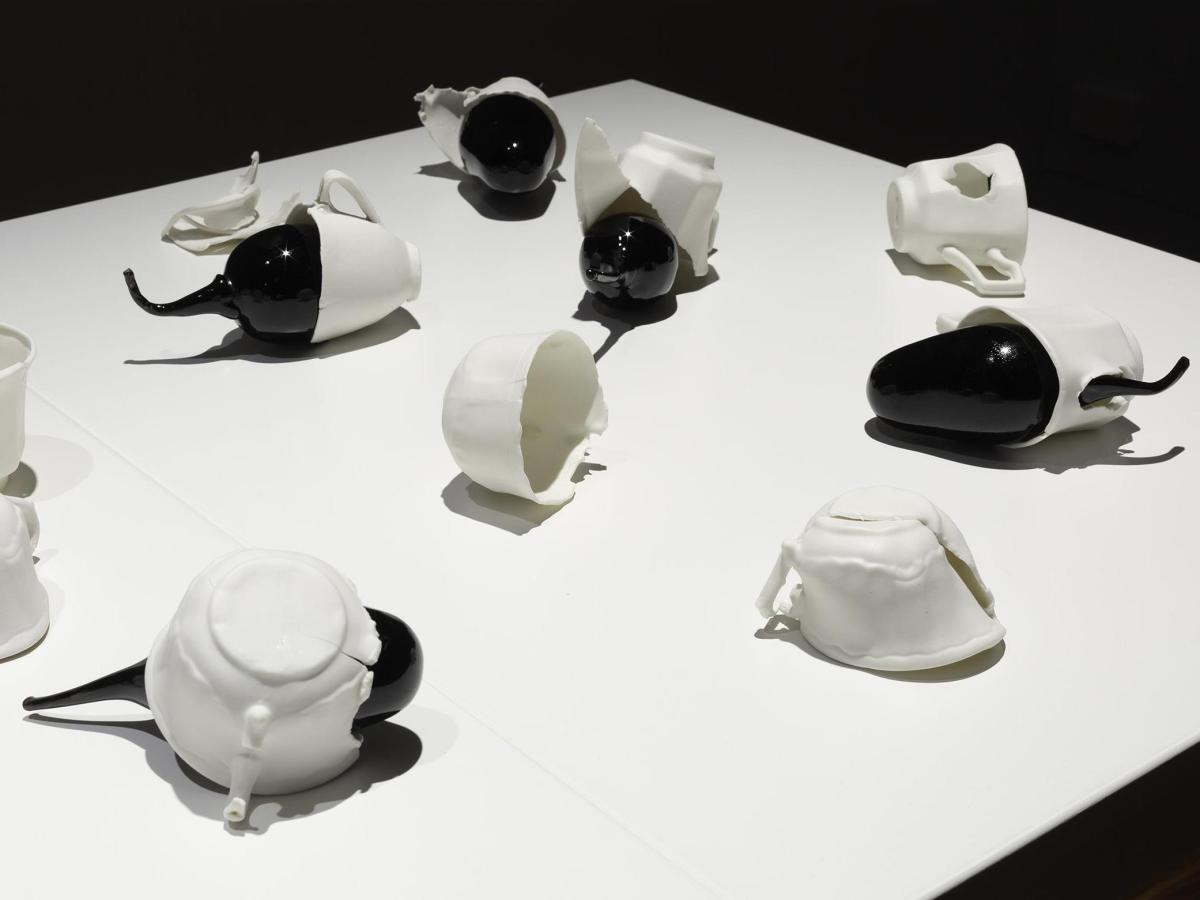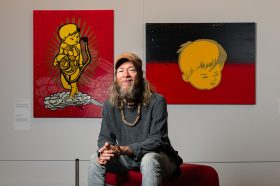Detail of Yhonnie Scarce’s winning work, Servant and Slave 2018, porcelain and hand-blown glass, dimensions variable; Courtesy the artist and This Is No Fantasy Dianne Tanzer + Nicola Stein, Melbourne, Image: Christian Capurro
Yhonnie Scarce has been named the recipient of Shepparton Art Museum’s $20,000 Indigenous Ceramic Award (ICA), regarded as the most prestigious national award for Indigenous ceramics in Australia, and one that pushes perceptions of the field.
‘Ceramics has become the contemporary art form of the day – a little like video art in the 1990s,’ said SAM Director, Dr Rebecca Coates.
‘Over the last few years, we’ve seen an increasing number of leading contemporary artists working in ceramics, extending our understanding of the medium while continuing to explore ideas and concerns that are central to their work.’
Scarce’s work is a case in point. Presented on a dining table, her installation Servant and Slave (2018) combines Scarce’s signature glass vessels with ceramic forms to tell a story of the oppressive behaviours during Aboriginal domestics’ employment.
Scarce told ArtsHub: ‘I think Indigenous ceramics have always been around, if you consider the long term practice of Ernabella and Hermannsburg Potters’. However, it is initiatives like the Indigenous Ceramic Award that have brought such practices to the fore, she said.
‘Ceramics and glass are no longer considered craft mediums but have acceptance within the contemporary art conversation,’ Scarce explained.
Coates added: ‘We are seeing particular styles, or schools develop with a definitive visual language and often recognised forms. At the same time, other artists are giving greater consideration to modes of display, creating installations, and thinking about how audiences experience the work. Gone is the solitary pot on the plinth!’
In total, seven artists were shortlisted for SAM’s Indigenous Ceramic Award are: Dean Cross (Worimi, ACT), Jackie Wirramanda (Wergaia, VIC), Jan Goongaja Griffiths (Miriwoonga/Ngarinyman, WA), Janet Fieldhouse (Torres Strait Islands, QLD) – who won the award in 2007 and 2011, Jock Puautjimi (Tiwi, NT), Penny Evans (Gamilaraay/Gomeroi, NSW), and Yhonnie Scarce (Kokathat/Nukunu, VIC). Each is funded to create a new body of work.
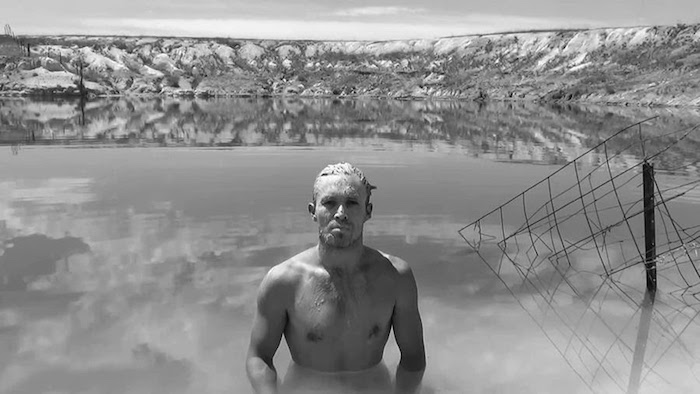
Dean Cross; courtesy and © the artist
Not dissimilar to Scarce in rethinking presentation, finalist Dean Cross has used clay from his Country to be responsive to the architecture of the gallery space and to challenge the Western canon of memorial statuary.
He told ArtsHub: ‘Being in this exhibition has meant a lot of surprised faces by people I know when I tell them I am part of it! The most common response has been “but I didn’t think you made ceramics?” And to be fair, I am not sure if my work technically is ceramic. It is a little like the bread/toast situation. At what point does a slice of bread become a piece of toast?
‘It can be very challenging when there are external expectations about the type of work one is supposed to produce. I feel [such expectations] to be dangerous to the young artist who should be free to explore,’ he added.
Coates expanded on this point: ‘We have had rumblings from some of our more traditional master craftsmen who can be concerned that with all these contemporary artists “discovering” the medium, often making a feature of the accident or the hand-made, and without years of craftsmanship and skill to inform their work, there is less room for their art and endeavours. I believe that great art always prevails.’
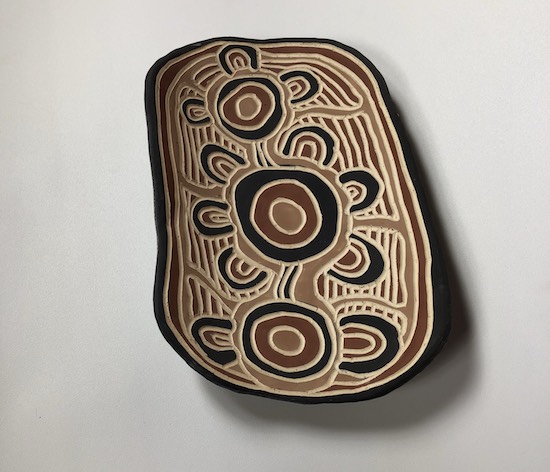
Jackie Wirramanda, Camping Grounds 2018, white clay (unglazed), 45 x 23 cm; Courtesy and © the artist.
Smashing the ceramic silos
Coates believes that Indigenous ceramics have been getting much greater visibility within the contemporary conversation over the past five to ten years.
The Indigenous Ceramic Award was established in 2007, after extensive consultation, to address an identified trend – that artists were responding to a perceived market pressure to focus or convert their practice to paint on canvas.
It was felt an award would celebrate both the historical and contemporary uses of clay, whilst stimulating growth in the practice.
Cross said that he felt incredibly privileged that the team at SAM decided to take a risk with his work and include it in the prize. ‘My work is made up of 230 handfuls of Ngunnawal ochre and responds to the volume of the space, not the walls containing it or the history of the building itself,’ he explained.
Using ochre from his home of Sutton in NSW, Cross said it is ‘more than just a material to make art with – it is a part of me. That’s why it is so good to use as an allusion to memory, and a repository of history and stories.
‘That connection to Country and to the materiality of clay is what excites me most about the work I see in the prize,’ he added.
Finalist Penny Evans shared this view: ‘Clay is the right medium for me because it is of the land and land is where our cultures reside.’
She continued: ‘As Aboriginal people who work with clay, we speak a common language and understand the many processes involved and the many challenges involved and also the endless possibilities involved through being ceramic artists.’
Evans’ work explores the fate of our freshwater mussels, which in some areas are nearing extinction as our rivers are starved of water.

Penny Evans, Waterhole Spirits 2018, dimensions variable; Courtesy and © the artist
Scarce’s winning work was selected for the way it speaks to difficult histories with a delicacy and resolved sophistication of language and material. Her broken and intentionally fragmented porcelain tea cups appear inhabited or co-opted by a series of black glass forms.
She said: ‘For this body of work, ceramics were central to the message … Much of this fine bone china was opulently embellished with flowers and gold trimming. I chose to scale down the impact of these cups by choosing cups with little embellishment … A neutral matt white seemed right as I didn’t want to glorify the female employers who had privileged themselves over the Aboriginal working women. The black gloss bush banana represents the stronger element, proudly honouring these Aboriginal women.’
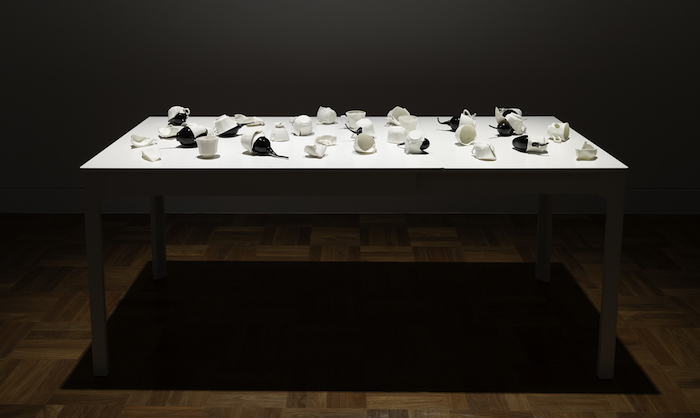
Installation view Yhonnie Scarce’s winning work, Servant and Slave 2018, porcelain and hand-blown glass, dimensions variable; Courtesy the artist and This Is No Fantasy Dianne Tanzer + Nicola Stein, Melbourne, Image: Christian Capurro
‘Each work in its own way rewrites the language of ceramics inflected through a personal cultural specificity,’ the Judging Panel said of this year’s group of finalists.
Scarce added: ‘It goes beyond simply industry recognition as there is so much more to be gained from the opportunity of being a finalist. Everyone is a winner in this prize process.’
This is the sixth edition of the acquisitive prize, and it comes at an important time in SAM’s history as it prepares to move to a new purpose-built museum towards the end of 2020.
The winning work, and that of the finalists, will be on display at the Shepparton Art Museum (VIC) from 25 August to 11 November 2018.
This year the ICA has been developed and managed by Project Curator Belinda Briggs, SAM’s Community Engagement Officer, Indigenous – a position that was initiated as a one-year residency supported by Creative Victoria and Greater Shepparton, and which was extended in April 2017 through the support of The University of Melbourne.
